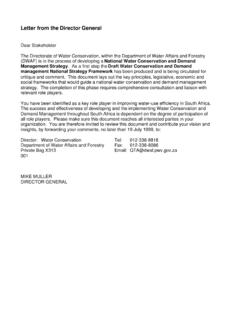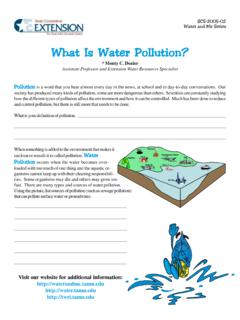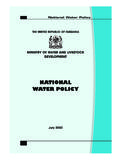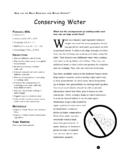Transcription of Definition of Conservation Agriculture - …
1 THE PARADIGM OF Conservation . Agriculture . J. Dumanski1, R. Peiretti2, J. R. Benites3, D. McGarry4, and C. Pieri5. 1. Consultant in Sustainable Land Management, Ottawa, Canada; 2 President of American Confederation of Farmers Associations for a Sustainable Agriculture , Argentina; 3 FAO. Representative in Argentina, Buenos Aires, Argentina; 4 Principal Scientist, Natural Resources, GoQ, Indooroopilly, Qld., Australia; 5 Scientific Director, Eco-Carbone, Paris, France. Email: Citation: Dumanski, J., R. Peiretti, J. Benetis, D. McGarry, and C. Pieri. 2006. The paradigm of Conservation tillage. Proc. World Assoc. Soil and water Conserv.
2 , P1: 58-64. Key Words: Conservation , Agriculture , Zero tillage, Erosion Submitted March 22, 2006. Approved August 6, 2006. Posted August 31, 2006. ABSTRACT. The concept of Conservation Agriculture (CA) is outlined in a series of principles and practices that are promoted. CA is an application of modern agricultural technologies to improve production while concurrently protecting and enhancing the land resources on which production depends. Application of CA promotes the concept of optimizing yields and profits while ensuring provision of local and global environmental benefits and services. Zero tillage, along with other soil Conservation practices, is the cornerstone of CA.
3 About 47% of the 95 million ha of zero tillage is practiced in South America, 39% in North America, 9% in Australia, and in Europe, Asia and Africa. INTRODUCTION. Conservation Agriculture is gaining acceptance in many parts of the world as an alternative to both conventional Agriculture and to organic Agriculture . Although the practice of Conservation Agriculture on a large scale emerged out of Brazil and Argentina, similar developments were occurring in many other areas of the world, notably North America in zero tillage, and Africa and Asia with technologies such as agroforestry. Conservation Agriculture is based on the principles of rebuilding the soil, optimizing crop production inputs, including labor, and optimizing profits.
4 2006 Proceedings of World Association of Soil and water Conservation Paper No. P1-7 58. Zero tillage is now applied on more than 95 million ha worldwide, primarily in North and South America (Derpsch, 2005). Approximately 47% of the zero tillage technology is practiced in South America, 39% is practiced in the United States and Canada, 9% in Australia and about in the rest of the world, including Europe, Africa and Asia. In deference to other approaches, Conservation Agriculture promotes a series of principles to achieve Conservation objectives, rather than a particular technology. This is in recognition of the fact that global Agriculture is practiced in many different ecosystems, and technologies have to be carefully tailored to be successful.
5 This article was prepared to outline these principles and to bring focus to the emerging paradigm of Conservation Agriculture . Definition OF Conservation Agriculture . Conservation Agriculture (CA) is not business as usual', based on maximizing yields while exploiting the soil and agro-ecosystem resources. Rather, CA is based on optimizing yields and profits, to achieve a balance of agricultural, economic and environmental benefits. It advocates that the combined social and economic benefits gained from combining production and protecting the environment, including reduced input and labor costs, are greater than those from production alone.
6 With CA, farming communities become providers of more healthy living environments for the wider community through reduced use of fossil fuels, pesticides, and other pollutants, and through Conservation of environmental integrity and services. Conservation Agriculture is the integration of ecological management with modern, scientific, agricultural production. Conservation Agriculture employs all modern technologies that enhance the quality and ecological integrity of the soil, but the application of these is tempered with traditional knowledge of soil husbandry gained from generations of successful farmers. This holistic embrace of knowledge, as well as the capacity of farmers to apply this knowledge and innovate and adjust to evolving conditions, ensures the sustainability of those who practice CA.
7 A major strength of CA is the step-like implementation by farmers of complementary, synergetic soil husbandry practices that build to a robust, cheaper, more productive and environmentally friendly farming system. These systems are more sustainable than conventional Agriculture because of the focus of producing with healthy soils. Conservation Agriculture promotes minimal disturbance of the soil by tillage (zero tillage), balanced application of chemical inputs (only as required for improved soil quality and healthy crop and animal production), and careful management of residues and wastes. This reduces land and water pollution and soil erosion, reduces long-term dependency on external inputs, enhances environmental management, improves water quality and water use efficiency, and reduces emissions of greenhouse gases through lessened use of fossil fuels.
8 Conservation Agriculture , including agroforestry (Figs. 1 and 2), specialty crops, and permanent cropping systems, promotes food sufficiency, poverty reduction, and value added production through improved crop and animal production, and production in relation to market opportunities. Reduced tillage leads to lessened human inputs, in both time and effort this is generally attractive overall, but it is critical in HIV-affected regions. Conservation Agriculture is best achieved through community driven development processes whereby local communities and farmer associations identify and implement the best options for CA in their location.
9 Local, regional and national farmer associations, working through community workshops, farmer-to-farmer training, etc., but with technical backstopping from Conservation professionals, are the main players in the promotion of CA. 2006 Proceedings of World Association of Soil and water Conservation Paper No. P1-7 59. Conservation Agriculture provides direct benefits to environmental issues of global importance. These include land degradation, air quality, climate change, biodiversity and water quality. Conservation Agriculture relates directly to the United Nations Framework Convention on Climate Change, the International Convention on Biodiversity, the United Nations Convention to Combat Desertification (Fig.)
10 3), and the various agreements on international waters. Figure 1. Integrated paddy rice and agroforestry in Madagascar. Figure 2. Integrated Agroforestry in Madagascar. 2006 Proceedings of World Association of Soil and water Conservation Paper No. P1-7 60. Figure 3. Mitigating the effects of desertification in Morocco. THE PRINCIPLES OF Conservation Agriculture . Conservation Agriculture emphasizes that the soil is a living body, essential to sustain quality of life on the planet. In particular, it recognizes the importance of the upper 0-20 cm of soil as the most active zone, but also the zone most vulnerable to erosion and degradation.









